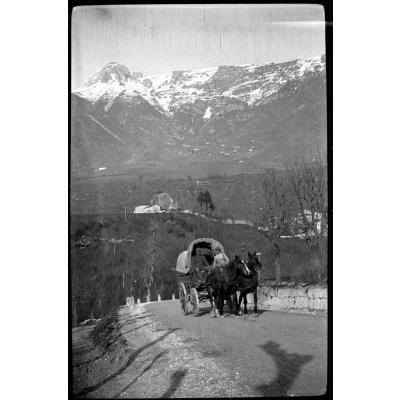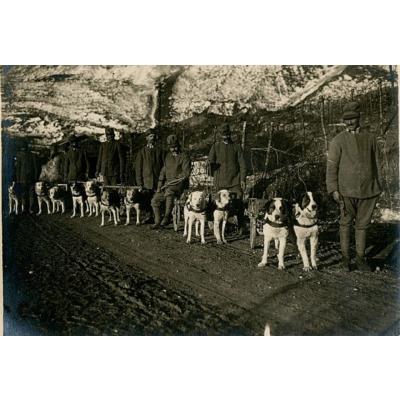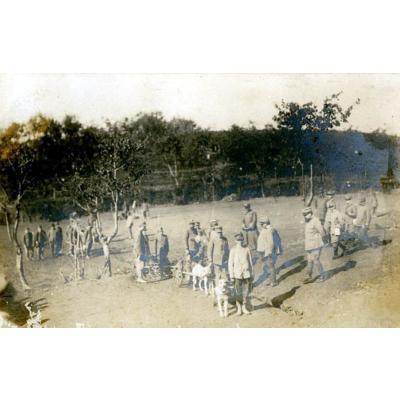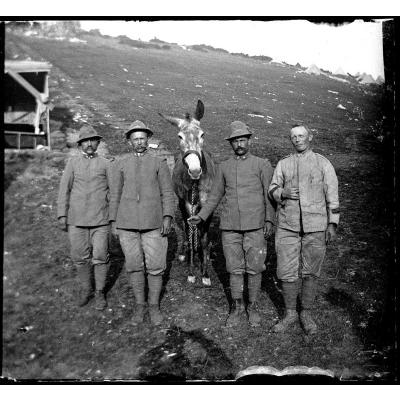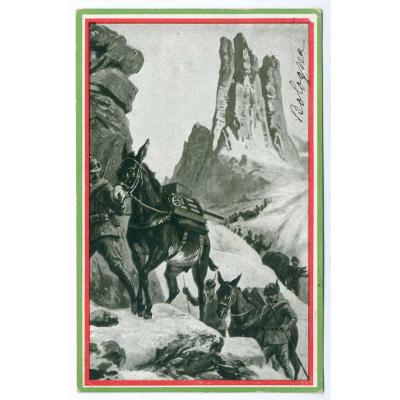Schede
“...Imagine then if there’s someone who thinks that there are also you beasts, who watch men and things with those silent eyes, and who knows how you see them, and what you think…” Luigi Pirandello.
People have used, exploited and occasionally loved animals since ancient times. Since old times they have used them at war. During the first world war horses, mules, donkeys, dogs, homing pigeons, poor animals who like most soldiers sent to the front, were sent to starve, to suffer thirst and to die for the glory of a homeland which never cared for them. It is estimated that horses used at the different fronts were almost 10 million, utilized to tow cannons, wagons for the complex of materials employed by the soldiers; in battle this animal experienced his last spring with Napoleone Bonaparte, who utilized it in overwhelming military posts, but then the improvement of the firearms led to the decline of cavalry, eliminating it completely during the first world war, in front of the tangles of barbed wire, with waves of 500 bullets per minute of the machine-guns. Neither the mule could escape his use during the war, it was precious for the transport of the luggage as an alternative of floats. Since the mid-eighteenth century up to the present day, all armies have utilized mules in departments of special forces; their physical features made it indispensable during the first world war at the mountain front, in the ratio three of them per cannon: one for the barrel, one for the carriage and one for the ammunition. Each animal was able to carry a weight of 150 kilos, on the back there was also the container of water; in this way they were able to shorten the walking time of the troops which could also last for 100 kilometers in 3 or 4 days. The donkey, father of the mule, served, with dignity, as a war auxiliary and no less than a horse or than his mule cub, as a beast of burden. In contrast to the submission of the horse to the men, it seems that the submission of the dog to the man was spontaneous, detecting the convenience. Since this discovery of the animal, the watchdog had its origins, more for the food it shared with the men than for his properties, to whom it completely didn’t care.
Mankind, in antiquity, paid attention to develop through crossbreeding particularly fierce breeds to utilize in war: Cyrus the Great, founder of the Persian empire, had in his troops ranks of very strong mastiffs; Assyrian and Babylonians used the Great Dane as a war dog. The invention of the gunpowder moderated the use of dogs in battle, but without completely excluding it, then the warlike dog disappeared, substituted during the Great War by the auxiliary dog. Even if it couldn’t do extreme services like horses or mules, the dog soon became a precious ally, excellent walker and swimmer, above all it had a better sense of smell, was versatile and adaptable on tough terrain. On the west front Germans utilized dogs of Dalmatian breed and Shepherd dogs as messengers and for the rescue of the injured and disbanded; in 1915 already about 2000 dogs, were in service, increased to 20000 in 1918, from which at the end of the conflict the guide dogs for blind soldiers were selected. Men realized that some animals had an extra-fine sense of direction: among them the homing pigeons were the most gifted. Even the Egyptian sailors used to embark with baskets full of pigeons they freed on the way back to signal ashore the arrival of the ships. The employment of pigeons evolved over time and were mostly the wars to stimulate their spread in Europe as messengers with very light containers tied to the feet. In 1914, all armies of the major powers had departments specialized in homing pigeons, with staff specialized in the training: none could compete with a pigeon in speed and distances covered in a short time. In Military Operation Zones, each divisional sect had four mobile dovecotes, commands between two and four. The concealment or the murder of a homing pigeons at the hands of a person was punished as if it were an attempt on a soldier in uniform: in November 1918 the general Boroeviç suspected the inhabitants of the invaded east Veneto region to hide the pigeons left by the retreating Italians: who didn’t hand them to the Hungerian soldiers were tried for treason. As well as the food emergency of the civil population being prevalent, everywhere, there was also the need of the soldiers at the front. To overcome such problems came the animals once again to help: the provisioning of the troops through canned meat was largely used by all armies.
The military establishments canned 173 millions cans of pork and beef, more than 62 millions were packaged by the private industry and in 1917 sent abroad. On the asiago Plateau the English did not lack cans, indeed they complained about always eating beef stew; it wasn’t so for the Austrians they had in front, who had to dramatically use the auxiliary animals, employed simultaneously at the front, in agriculture and as food. The 22000 draft horses only of the Austro-Hungarian army in March 1918 were reduced to less than 2000, donkeys and mules were halved from the starting 15000; livestock had even worse luck, it was almost entirely requisitioned and eaten. On the 20th June 1918, in the diary of the 14th of the Slovak-Hungarian division, located along the Piave, we can read: “at 12:45 we have received word that the 75th regiment, after severe losses and the complete lack of food, is absolutely not able to attack…”. The regularity of the supplies depended on the logistical conditions of the backline and on the number of animals utilized for transporting food up to the soldiers at the forefront; who ate was able to attack or resist; without food the soldier, who was subject to an extraordinary daily deterioration, he didn’t go anywhere. The animals of the auxiliary departments, silent heroes, helped the victorious fate of the Great War.
Traduzione di Matilde Zanotti, in collaborazione con il Liceo Linguistico Internazionale C. Boldrini di Bologna, marzo 2022.

